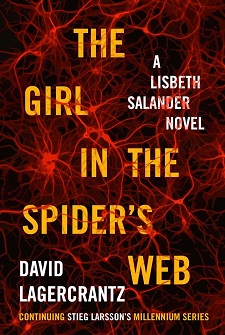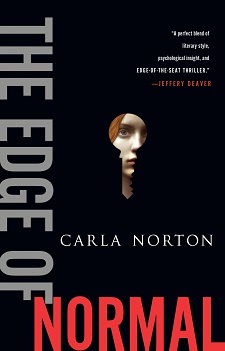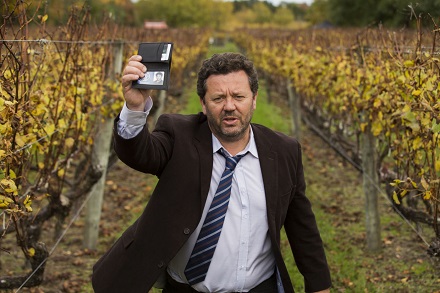By OLINE H. COGDILL

On Tuesday—Sept. 1, 2015, for those of you reading this later—Lisbeth Salander, that much tattooed “girl,” and journalist Mikael Blomkvist make their return in a new novel with a most long-winded title.
The Girl in the Spider's Web: A Lisbeth Salander Novel, Continuing Stieg Larsson's Millennium Series by David Lagercrantz practically deserves its own sentence.
The author of this novel, which continues what most of us call The Girl With the Dragon Tattoo series, is, of course, not Stieg Larsson, who died of a heart attack in 2004 at age 50.
Larsson, a Swedish journalist and writer, didn’t live to see the publication of his first novel. The Girl With the Dragon Tattoo, as well as the other two novels in the trilogy, The Girl Who Played with Fire and The Girl Who Kicked the Hornet's Nest, were published posthumously.
Like Larsson, Lagercrantz is a Swedish journalist and author who has worked as a crime reporter. He has several novels to his credit, and has won awards for his work in Sweden.
My first question is for Mystery Scene readers: Will you be buying and/or reading this new continuation of the story? My second question is why?
I don’t plan to read or review The Girl in the Spider's Web.
I don’t understand the need to continue this series after Larsson’s death. Larsson gave us three intriguing, though overwritten novels, and an unusual and compelling character in Lisbeth. Unfortunately, he died before he could continue the novels, so let’s be content with what he left.
I loved the Larsson’s novels, though I thought each needed heavy editing and were too long. But the creation of Lisbeth overcame any problems and made me want to read all three novels.
I can understand readers’ interest in more stories from the likes of Robert Ludlum, Robert B. Parker, and Ian Fleming because those authors’ works were in the public eye for a longer time. But publishers and readers should be looking for new stories and new authors, and there certainly are enough around.
Instead of this new book, I think we should celebrate what Larsson’s original trilogy meant to readers.
First, it showed the world what mystery readers have long known: This community of readers is among the most highly educated and discerning of readers. They will accept any character, even one outside of their comfort level, if the stories are engaging enough. Lisbeth certainly falls into this area—an antisocial hacker with mad computer skills given to violence and heavily tattooed. And we wanted to know more and more about her.
Second, it reaffirmed that international settings are big with mystery readers. Publishers such as Soho Crime have long known this and delivered provocative crime stories set in countries other than Great Britain.
Larsson’s novels didn’t start the trend of more crime fiction set abroad and published in America. But his novels made publishers realize this was an untapped market that continues to grow.
So if you are looking for a few authors with novels with an international setting, here are a few to consider, in no particular order. I also wrote about other international writers on a previous blog. Find it here.
And please feel free to add your favorites. I am sure I missed some:
Elizabeth Hand, Available Dark, set in Finland and Iceland
Cara Black, Paris
Arnaldur Indridason, Iceland
Martin Limon, Korea
Barry Lancet, Japan (and San Francisco)
Qiu Xiaolong, Shanghai
Nele Neuhaus, Germany
Scandinavian
Jussi Adler-Olsen, Copenhagen, Denmark
Karin Alvtegen, Sweden
Sara Blaedel, Copenhagen, Denmark
K.O. Dahl, Oslo, Norway
Ake Edwardson, Gotesborg, Sweden
Kjell Eriksson, Libro, Sweden
Karin Fossum, Norway
Anne Holt, Oslo, Norway
Matti Joensuu, Helsinki, Finland
Lene Kaaberbol, Copenhagen Denmark
Mons Kallentoft, Fjallbacka, Sweden
Lars Kepler, Tumba, Sweden
Camilla Läckberg, Sweden
Asa Larsson, Sweden
Henning Mankell, Sweden, among other locales
Liza Marklund, Sweden
Jo Nesbo, Oslo, Norway
Hakan Nesser, a country much like Sweden
Kristina Ohlsson, Stockholm, Sweden
Hakan Ostlundh, The Intruder, Fårö, off Gotland, Sweden
Anders Roslund, Stockholm, Sweden
Yrsa Sigurdardottir, Reykjavik, Iceland
James Thompson, Finland
Maj Sjowall and Per Wahloo, Sweden
Helene Tursten, Gothenburg, Sweden
Jan Costin Wagner, Turku, Finland

 The final installment of the Camille Verhoeven trilogy
The final installment of the Camille Verhoeven trilogy


 Click the letters to reveal the title of this mystery novel!
Click the letters to reveal the title of this mystery novel! 




 I have my favorites, authors in the genre whose books I look forward to with great anticipation because I know their work will transport me. You will know their names: Daniel Woodrell, Megan Abbott, Philip Kerr, Don Winslow, Ken Bruen, SJ Rozan, Dennis Lehane. The list is longer, but not very much longer.
I have my favorites, authors in the genre whose books I look forward to with great anticipation because I know their work will transport me. You will know their names: Daniel Woodrell, Megan Abbott, Philip Kerr, Don Winslow, Ken Bruen, SJ Rozan, Dennis Lehane. The list is longer, but not very much longer.
